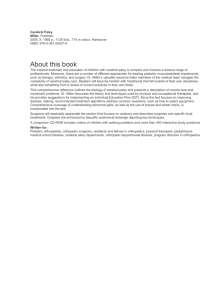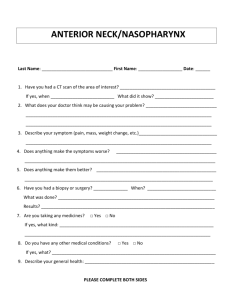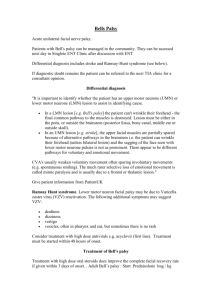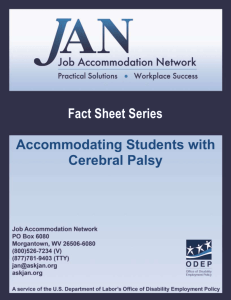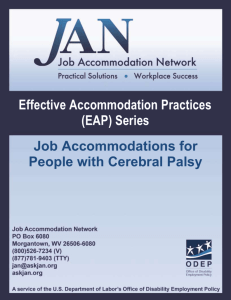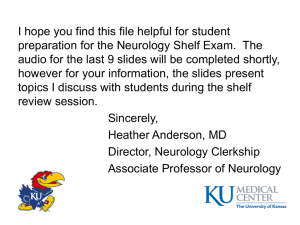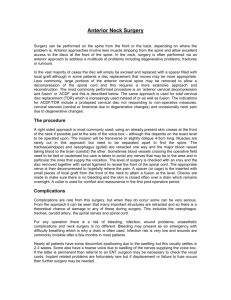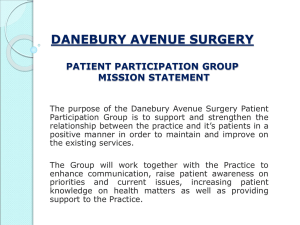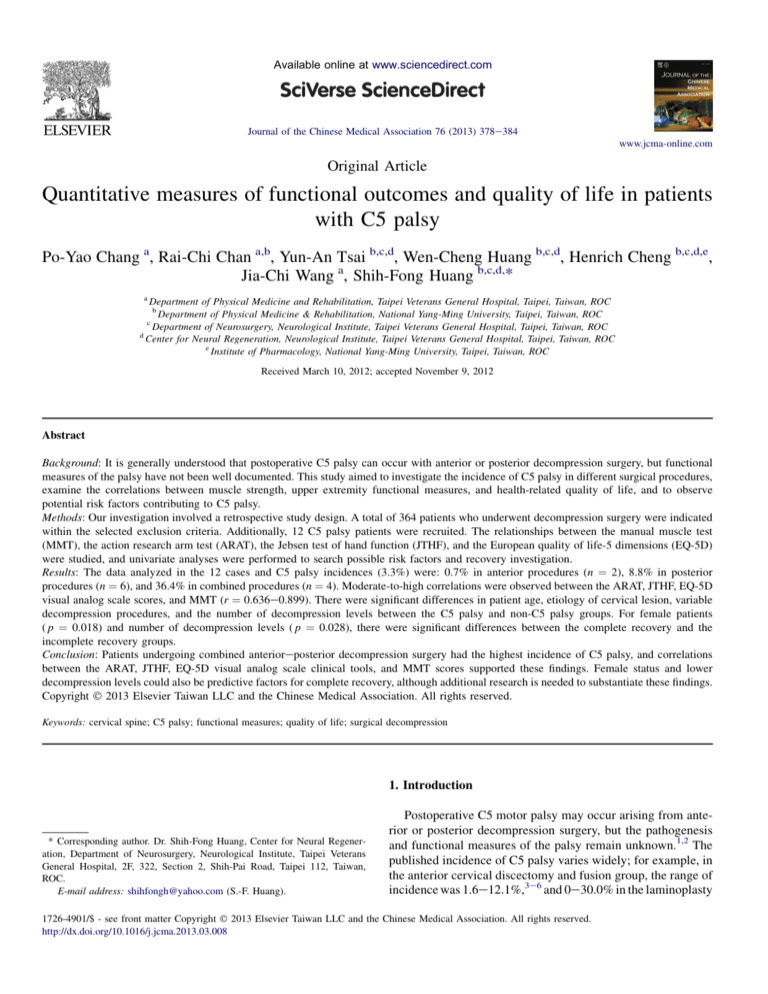
Available online at www.sciencedirect.com
Journal of the Chinese Medical Association 76 (2013) 378e384
www.jcma-online.com
Original Article
Quantitative measures of functional outcomes and quality of life in patients
with C5 palsy
Po-Yao Chang a, Rai-Chi Chan a,b, Yun-An Tsai b,c,d, Wen-Cheng Huang b,c,d, Henrich Cheng b,c,d,e,
Jia-Chi Wang a, Shih-Fong Huang b,c,d,*
a
Department of Physical Medicine and Rehabilitation, Taipei Veterans General Hospital, Taipei, Taiwan, ROC
b
Department of Physical Medicine & Rehabilitation, National Yang-Ming University, Taipei, Taiwan, ROC
c
Department of Neurosurgery, Neurological Institute, Taipei Veterans General Hospital, Taipei, Taiwan, ROC
d
Center for Neural Regeneration, Neurological Institute, Taipei Veterans General Hospital, Taipei, Taiwan, ROC
e
Institute of Pharmacology, National Yang-Ming University, Taipei, Taiwan, ROC
Received March 10, 2012; accepted November 9, 2012
Abstract
Background: It is generally understood that postoperative C5 palsy can occur with anterior or posterior decompression surgery, but functional
measures of the palsy have not been well documented. This study aimed to investigate the incidence of C5 palsy in different surgical procedures,
examine the correlations between muscle strength, upper extremity functional measures, and health-related quality of life, and to observe
potential risk factors contributing to C5 palsy.
Methods: Our investigation involved a retrospective study design. A total of 364 patients who underwent decompression surgery were indicated
within the selected exclusion criteria. Additionally, 12 C5 palsy patients were recruited. The relationships between the manual muscle test
(MMT), the action research arm test (ARAT), the Jebsen test of hand function (JTHF), and the European quality of life-5 dimensions (EQ-5D)
were studied, and univariate analyses were performed to search possible risk factors and recovery investigation.
Results: The data analyzed in the 12 cases and C5 palsy incidences (3.3%) were: 0.7% in anterior procedures (n ¼ 2), 8.8% in posterior
procedures (n ¼ 6), and 36.4% in combined procedures (n ¼ 4). Moderate-to-high correlations were observed between the ARAT, JTHF, EQ-5D
visual analog scale scores, and MMT (r ¼ 0.636e0.899). There were significant differences in patient age, etiology of cervical lesion, variable
decompression procedures, and the number of decompression levels between the C5 palsy and non-C5 palsy groups. For female patients
( p ¼ 0.018) and number of decompression levels ( p ¼ 0.028), there were significant differences between the complete recovery and the
incomplete recovery groups.
Conclusion: Patients undergoing combined anterioreposterior decompression surgery had the highest incidence of C5 palsy, and correlations
between the ARAT, JTHF, EQ-5D visual analog scale clinical tools, and MMT scores supported these findings. Female status and lower
decompression levels could also be predictive factors for complete recovery, although additional research is needed to substantiate these findings.
Copyright Ó 2013 Elsevier Taiwan LLC and the Chinese Medical Association. All rights reserved.
Keywords: cervical spine; C5 palsy; functional measures; quality of life; surgical decompression
1. Introduction
* Corresponding author. Dr. Shih-Fong Huang, Center for Neural Regeneration, Department of Neurosurgery, Neurological Institute, Taipei Veterans
General Hospital, 2F, 322, Section 2, Shih-Pai Road, Taipei 112, Taiwan,
ROC.
E-mail address: shihfongh@yahoo.com (S.-F. Huang).
Postoperative C5 motor palsy may occur arising from anterior or posterior decompression surgery, but the pathogenesis
and functional measures of the palsy remain unknown.1,2 The
published incidence of C5 palsy varies widely; for example, in
the anterior cervical discectomy and fusion group, the range of
incidence was 1.6e12.1%,3e6 and 0e30.0% in the laminoplasty
1726-4901/$ - see front matter Copyright Ó 2013 Elsevier Taiwan LLC and the Chinese Medical Association. All rights reserved.
http://dx.doi.org/10.1016/j.jcma.2013.03.008
P.-Y. Chang et al. / Journal of the Chinese Medical Association 76 (2013) 378e384
group.7e10 Most studies have been limited by a small number of
cases and dependence on specialized institutions. This study
will investigate the incidence of C5 palsy after various surgical
procedures.
Although controversy regarding the various mechanisms
underlying postoperative C5 palsy still exists, the importance
of the functional measures and quality of life regarding this
issue have recently garnered attention. Objective functional
measures of C5 palsy following cervical decompression surgery have not yet been fully established. However, most
studies have used a manual muscle test (MMT) grade and the
Japanese Orthopedic Association (JOA) score to present the
severity and neurological recovery rate,2,11,12 but both tools
may not be specific to an upper extremity functional measure.
Thus, we used two functional outcome evaluation tools: the
action research arm test (ARAT),13 and the Jebsen test of hand
function (JTHF),14 for upper extremity functional outcome
evaluation. In addition to the importance of functional measures, we also emphasized the quality of life (QoL) investigation in the C5 palsy group. QoL assessed patients’ success
or achievements in life domains that are considered important
to most people, including physical, social, and mental issues.
Researching the QoL of C5 palsy patients was important
because it helped the clinician to recognize these patients’
level of satisfaction with the postoperative motor palsy event.
This analysis also provided clinicians with information on
dose adjustments for pain management, demand for psychological support, and motivation to rehabilitate. In this study,
the European quality of life-5 dimensions (EQ-5D) was used
as a self-rated assessment of health status of clinical
outcomes.15
A previous study discussed the possible poor surgical
outcome factors in patients with cervical myelopathy,16 but it
lacked a correlation between objective upper extremity functional measures and surgical factors analysis in postoperative
C5 palsy. Therefore, it seems reasonable to survey these relationships with respect to this issue to clarify and prevent this
major morbidity.
The two specific aims of the current study were: (1) to
investigate the incidence of C5 palsy following cervical
379
decompression surgery and identify differences based on these
three surgical procedures; and (2) to analyze the correlation of
functional measures and QoL related to MMT.
2. Methods
2.1. Study design
This was a retrospective study that analyzed the variant
incidences of C5 palsy in all patients following cervical
decompression surgery and their functional measures in order
to clarify the possible risk factors for this major morbidity. The
study was approved by the Institutional Review Board of
Taipei Veterans General Hospital, and the patients gave
informed consent before participation.
2.2. Recruitment and data collection
There were 401 patients who underwent cervical decompression surgery between January 2009 and September 2010 at
Taipei Veterans General Hospital, Taipei, Taiwan. The surgical
data bank was searched using surgical codes such as anterior
cervical decompression, posterior cervical decompression, and
combined anterioreposterior cervical decompression to enroll
cases.
Exclusion criteria were: (1) evidence of spinal cord injury;
(2) previous traumatic cervical spine injury or cervical spine
fracture history; (3) spinal tumor or vascular malformation;
and (4) evidence of spinal infection extending to the disks or
spinal canal. A total of 37 patients were ineligible for the
exclusion criteria. The remaining 364 patients with cervical
disease underwent cervical decompression surgery (285
anterior, 68 posterior, 11 combined anterioreposterior) at the
hospital. Their ages ranged from 19 years to 84 years, with a
mean standard deviation (SD) of 55.9 12.0 years, and
included 224 men and 140 women. Various cervical lesions for
surgical decompression are presented in Table 1.
Most studies generally used the inclusion criteria of C5
palsy that were a deterioration of the muscle strength of the
deltoid or biceps brachii by at least one grade in a standard
Table 1
Patient characteristics and incidence of C5 palsy for different procedures.
Decompression procedures
Anterior approach
Posterior approach
Combined anterioreposterior
approach
p
Age (y, mean SD)
Gender (M/F)
54.3 11.7
178/107
No. of palsy cases (%)
62.4 11.7 *
45/23
No. of palsy cases (%)
58.7 10.5
10/1
No. of palsy cases (%)
<0.001
1/108 (0.9%)
1/46 (2.2%)
0/106 (0%)
0/23 (0%)
0/2 (0%)
2/285 (0.7%)
6/50 (12%)
0/2 (0%)
0/3 (0%)
0/13 (0%)
0/0 (0%)
6/68 (8.8%)
3/6 (50%)
0/1 (0%)
0/2 (0%)
1/2 (50%)
0/0 (0%)
4/11 (36.4%)
<0.001
0.006
<0.001
0.16
1.000
Cervical lesion a
CSM
CSR
Disc herniation
OPLL
CSA
Total
*p < 0.001 by one way analysis of variance (ANOVA) between anterior approach and posterior approach procedure.
CSA ¼ cervical spondylotic amyotrophy; CSM ¼ cervical spondylotic myelopathy; CSR ¼ cervical spondylotic radiculopathy; OPLL ¼ ossification of posterior
longitudinal ligament; SD ¼ standard deviation.
a
Fisher’s exact test.
380
P.-Y. Chang et al. / Journal of the Chinese Medical Association 76 (2013) 378e384
MMT, without aggravation of lower extremity function. In
addition to meeting the previous inclusion criteria, we used
stricter inclusion criteria of C5 palsy that the muscle strength
of the affected extremity must be normal grade in a standard
MMT before surgery for the purpose of eliminating the
baseline variability. Charts were reviewed and the diagnosis of
C5 palsy recorded in the charts confirmed. A total of 12 patients met the selection criteria. All participants were recruited
from the neurosurgery inpatient ward via neurosurgeons or
neurosurgery outpatient department follow-up group via a
research assistant by telephone. All recruitments for each of
the 12 patients occurred at an average of 4 months after surgery (range 1e6.5 months).
The assessment process consisted of the following steps.
First, all patients meeting the study criteria were given a detailed
explanation of the study, and signed informed consents before
participation. Then, all participants received an initial screening
by a rehabilitation physician to confirm their C5 palsy diagnosis
and assess their current muscle strength. Next, an occupational
therapist carried out the two upper extremity functional measures. A research assistant interviewed these patients with the
Chinese version of the EQ-5D questionnaire for QoL assessment.17 The assessment duration ranged from 30 minutes to 60
minutes, with a typical length of 45 minutes. The rehabilitation
physician then proceeded, and the survey protocol included
separate measures of physical symptoms, preoperative/intraoperative factors, surgical procedure, and overall post-C5 palsy
treatment course from individual chart records. All patients had
undergone conventional rehabilitation, consisting of 2 hours of
daily therapy 3e4 times a week during the inpatient period.
2.3. Surgical techniques
Three types of surgical techniques have been previously
described in detail, and include anterior cervical discectomy
and fusion (ACDF),18,19 posterior decompression surgery
(laminoplasty),20,21 and anterior cervical microdiscectomy
combined with posterior decompression surgery.22
In this study, the ACDF area varied from 1e4 intervertebral
disc levels. Spinal fusion was performed with an autologous
iliac crest or fibula bone graft. Internal fixation devices such as
a plate and screw system were used for fusion surgery of three
or more levels.
In posterior decompression surgery, laminectomy levels
varied from a single intervertebral disc level to five intervertebral disc levels. An iliac crest autograft, harvested from the
right iliac crest site, or a fibula bone graft, was then applied
after routine decortication. Construction devices such as a
plate and lateral mass screw system were used for three or
more levels.
The anterior approach combined with posterior laminectomy and fusion was usually indicated in cases with
obvious cervical myelopathy or ossification of posterior longitudinal ligament at multiple levels. Owing to the complex
procedures, the surgical duration was significantly increased.
As in previous surgical procedures, autologous graft and
construction devices were also used in this procedure.
2.4. Measurement tools
The ARAT13,23 is an observational test used to assess upper
extremity function and impairment. The test comprises 19
items grouped into subtests (grasp, grip, pinch, and gross arm
movement), and uses a four-point quantitative scale (0 ¼ no
movement possible, 1 ¼ movement partially performed,
2 ¼ movement performed but abnormally, and 3 ¼ movement
performed normally). The maximum obtainable score is 57.
Three manual tasks adapted from the JTHF14,24 were used
to evaluate upper extremity dexterity: (1) picking up small
common objects; (2) picking up large light objects; and (3)
picking up large heavy objects. Patients were instructed to
complete each task as fast as they could and the time to
complete each task was thereafter analyzed.
The EQ-5D self-classifier assesses the five dimensions of
mobility, self-care, usual activity, pain/discomfort, and anxiety/
depression in three degrees (none, moderate, and extreme).15 It
can be used to generate a single index derived from valuations of
the health state. The EQ-5D consists of a self-rated visual analog
scale (VAS) that allows people to classify and rate their overall
health status on the day of the survey.
2.5. Statistical analysis
Statistical analyses were conducted using the SPSS 17.0
software (SPSS Inc., Chicago, IL, USA). Quantitative data are
presented as the mean SD. All potential risk factors and recovery investigation used in the univariate analysis were
assessed between groups. Continuous variables were compared
using one-way analysis of variance (ANOVA; Table 1), independent t test (Table 3), or ManneWhitney U test (Table 5).
Categorical variables were assessed using Chi-square test or
Fisher’s exact test. The relationship between the scores in the
upper extremity subscale of the ARAT, JTHF, and in the C5
MMT were examined using nonparametric statistical method
Spearman’s correlation coefficient method. A multivariable
analysis was determined using stepwise linear regressions,
considering all variables with p < 0.05 to be candidate variables.
An r value between 0 and 0.25 was considered to represent a low
association, a value of between 0.25 and 0.5 represented a fair
association, a value of between 0.5 and 0.75 represented a
moderate association, and a value > 0.75 represented a high
association.25 A p value <0.05 was considered significant.
3. Results
Table 1 presents patients’ characteristics, the number of
cases of postoperative C5 palsy, and the percentage of C5
palsy cases among the total number of C5 palsy cases for each
category by surgical procedure. The average age of patients in
the anterior approach group was significantly less than in the
posterior approach group ( p < 0.001). The etiology of cervical
lesions of operation was significantly different among the
three groups as determined by Fisher’s exact test as follows:
cervical spondylotic myelopathy ( p < 0.001); cervical spondylotic radiculopathy ( p ¼ 0.006); disc herniation
P.-Y. Chang et al. / Journal of the Chinese Medical Association 76 (2013) 378e384
381
Table 2
Summary of demographic data from 12 patients with C5 palsy.
Case no.
Age (y)/sex
1
2
3
4
5
6
7
8
9
10
11
12
Mean SD
58/F
60/F
57/M
53/F
77/M
71/M
65/M
81/M
58/M
62/M
51/M
80/M
64.4 10.4
C5 palsy onset
MMT grade
Operative data
Pain (d)
Weak (d)
Preop
Onset
FU
Hb (g/L)
Blood loss (mL)
Level (n)
Period (min)
0.5
2
1
2
3
1
3
2
1
1
1
2
1.6 0.8
1
3
2
4
3
2
3
3
1
2
1
5
2.5 1.2
5
5
5
5
5
5
5
5
5
5
5
5
5.0
4
4
4
1
3
3
1
2
0
0
1
2
2.1 1.5
5
5
5
5
3
3
2
2
2
2
1
1
3.0 1.6
151
116
160
155
108
129
118
123
133
142
157
143
136 18
150
50
150
500
150
1400
200
250
200
650
500
700
408.3 379.5
4
1
2
2
5
3
4
4
3
5
5
4
3.5 1.3
210
145
290
650
325
180
185
465
165
470
440
230
312.9 159.5
FU ¼ follow-up; Hb ¼ hemoglobin; MMT ¼ manual muscle test; SD ¼ standard deviation.
( p < 0.001); ossification of posterior longitudinal ligament
( p ¼ 0.16). The incidence of C5 palsy was two of 285 cases
(0.7%) in the anterior approach group, six of 68 cases (8.8%)
in the posterior approach group, and four of 11 cases (36.4%)
in the combined approach group.
The mean SD age of the 12 patients (9 men and 3
women) at the time of surgery was 64.4 10.4 years (range
53e81 years; Table 2). The clinical demographic data were as
follows: time to onset of pain, 1.6 0.8 days; time to onset of
muscle weakness, 2.5 1.2 days; further detailed data are
presented in Table 2.
The total score for the ARAT was 41.1 21.4 points; further
detailed subscales for ARAT are presented as follows: grasp
movement (13.3 7.0 points), grip movement (9.1 4.8
Table 3
Potential risk factors analysis for C5 palsy following decompression surgery.
Variable
Non-C5 palsy
patients
(n ¼ 352)
C5 palsy
patients
(n ¼ 12)
p
Age (y, mean SD)a
Gender (M/F)
Cervical lesion (%)
CSM
CSR
Disc herniation
OPLL
CSA
Decompression procedures
Anterior approach
Posterior approach
Combined anteriorposterior approach
Hb (g/L)
Blood loss (mL)
Decompression levels (n)
Operation period (min)
55.6 12.0
224/128
64.4 10.4
9/3
0.013
0.549
154 (93.9%)
48 (98.0%)
111 (100%)
37 (97.4%)
2 (100%)
10 (6.1%)
1 (2.0%)
0 (0%)
1 (2.6%)
0 (0%)
0.007
1.0000
0.021
1.0000
1.0000
283 (99.3%)
62 (91.2%)
17 (81.0%)
2 (0.7%)
6 (8.8%)
4 (19.0%)
<0.001b
132 16
308.9 276.7
2.9 0.9
280.8 118.6
136 18
408.3 379.5
3.5 1.3
312.9 159.5
0.397
0.227
0.026
0.362
CSA ¼ cervical spondylotic amyotrophy; CSM ¼ cervical spondylotic
myelopathy; CSR ¼ cervical spondylotic radiculopathy; Hb ¼ hemoglobin;
OPLL ¼ ossification of posterior longitudinal ligament; SD ¼ standard
deviation.
a
Independent t test.
b
Indicates that p was calculated using the overall of all variables listed
under the subheading.
points), pinch movement (13.8 6.8 points), and gross movement (4.9 3.7 points). The time taken to complete the JTHF
task was as follows: picking up small objects (11.6 3.0 seconds), picking up large light objects (11.6 9.4 seconds), and
picking up large heavy objects (11.7 8.3 seconds). The
average index and VAS score for EQ-5D were 0.617 0.194 and
69.8 12.9 points, respectively.
Univariate analysis of potential risk factors studied for C5
palsy following decompression surgery showed statistically
significant difference between the groups for the following
variables: age, etiology of cervical lesion, variable decompression procedures, and the number of decompression levels
(Table 3).
The correlation between the subscales of the ARAT and
MMT at follow-up were moderate to high (r ¼ 0.636e0.730
for pinch, grasp, and grip; r ¼ 0.803e0.899 for total ARAT
and gross movement; Table 4). The JTHF scores were highly
correlated with MMT scores at follow-up (r ¼ 0.845e0.867;
Table 4), and the EQ-5D VAS score presented a moderate
correlation with MMT scores at the follow-up. Correlation
between EQ-5D index and MMT scores was not statistically
significant ( p ¼ 0.057). However, in a stepwise linear
regression model including all the previous mentioned parameters, only gross movement remained significantly associated with MMT scores ( p < 0.001).
Table 5 presents demographic characteristics of patients
with complete recovery and incomplete recovery. There were
significant differences in female patients ( p ¼ 0.018) and the
number of decompression levels ( p ¼ 0.028) between the
complete recovery and incomplete recovery group. Age, time
from surgery to pain onset, time from surgery to C5 palsy
development, MMT at onset, variable decompression procedures, hemoglobin, blood loss amount, and operation period
were not statistically significant.
4. Discussion
C5 palsy was found in 12 of the 364 patients who underwent
cervical decompression surgery, and the overall incidence was
3.3%. The incidence of C5 palsy at our institute was as follows:
382
P.-Y. Chang et al. / Journal of the Chinese Medical Association 76 (2013) 378e384
Table 4
Correlations between MMT grade and ARAT, JTHF, and EQ-5D.
MMT grade at
follow-up
ARAT
Total score
Grasp
Grip
Pinch
Gross movement
JTHF
Pick up small objects
Pick up large light objects
Pick up large heavy objects
EQ-5D
EQ-5D index
ED-5D VAS
Linear multiple
regression
Spearman’s
coefficient
p
p
0.803
0.663
0.730
0.636
0.899
0.002
0.019
0.007
0.026
<0.001
0.682
0.601
0.685
0.775
<0.001
0.845
0.858
0.867
0.001
<0.001
<0.001
0.710
0.430
0.867
0.562
0.635
0.057
0.026
0.411
ARAT ¼ action research arm test; EQ-5D ¼ European Quality of Life-5 Dimensions; JTHF ¼ Jebsen test of hand function; MMT ¼ manual muscle test;
VAS ¼ visual analog scale.
anterior cervical discectomy and fusion (0.7%), posterior surgery (8.8%), and combined anterioreposterior surgery (36.4%).
Our study indicated a lower incidence of C5 palsy for the
anterior surgery group than in previous studies (0.7% vs.
4.3%).26 Greiner-Perth et al27 described a C5 palsy incidence of
4.6% in the fusion of one or two levels group and 12.5% in the
fusion of three or more levels group. Hashimoto et al28 reported
a C5 palsy incidence of 2.7% in the fusion of one or two levels
Table 5
Demographic characteristics of patients with complete recovery and incomplete recovery.
Variable
Complete recovery Incomplete recovery p
patients (n ¼ 8)b
patients (n ¼ 4)a
Age (y, mean SD)c
Gender (M/F)
Pain onset after surgery (d)
C5 palsy developed after
surgery (d)
MMT at onset
MMT at F/U
Decompression procedures
Anterior approach
Posterior approach
Combined anteriore
posterior approach
Hb (g/L)
Blood loss (mL)
Decompression levels (n)
Operation period (min)
57 2.9
1/3
1.4 0.8
2.5 1.3
68.1 10.9
8/0
1.8 0.9
2.5 1.3
0.073
0.018
0.57
0.933
3.3 1.5
5.0 0
1.5 1.2
2.0 0.8
0.073
0.004
2
1
1
0
5
3
0.188
146 20
212.5 197.4
2.3 1.3
323.8 225.4
132 16
506.3 420.4
4.1 0.8
307.5 134.5
0.283
0.073
0.028
0.933
ARAT ¼ action research arm test; EQ-5D ¼ European Quality of Life-5 Dimensions; FU ¼ follow-up; JTHF ¼ Jebsen test of hand function;
MMT ¼ manual muscle test; SD ¼ standard deviation; VAS ¼ visual analog
scale.
a
Complete recovery indicates that the patient’s manual muscle test grade
is 5.
b
Incomplete recovery indicates that the patient’s manual muscle test grade
is 4.
c
ManneWhitney U test.
group and 11.9% in the fusion of three or more levels group.
These previous studies indicated that the incidence of C5 palsy
tended to increase parallel to the number of levels fused. In the
anterior surgery group, we found that two of 223 patients (2.7%)
developed C5 palsy after the fusion of one or two levels, and
none of the 62 patients (0%) developed palsy after the fusion of
three or more levels. The percentage of the fusion of three or
more levels in all anterior surgery groups was 27.8% in our
study. By contrast, the percentage of fusion of three or more
levels in all anterior surgery groups in the Greiner-Perth et al27
and Hashimoto et al28 studies was 46.3% and 63.6%, respectively. The lower percentage of multiple-level fusion procedures
in the present study may explain the lower incidence of C5 palsy.
The average age of patients and the cervical lesions of
operation etiology were significantly different among the three
groups in our study. This may be explained by the complexity
of surgical decision-making in accordance with the patients’
choice. Before surgery, we explained to the patients our previous surgical results of ACDF, posterior decompression surgery (laminoplasty), and combined surgery, including
neurologic recovery, surgery-related complications, and postoperative neck immobilization with a cervical orthosis. In our
experience, the anterior approach usually yielded better surgical outcomes and reduced frequency of postoperative neck
pain due to injury to the nuchal muscle, so it was preferable to
use the anterior approach in the general population. However,
the disadvantage of ACDF is that it required a longer postoperative immobilization of the neck with a cervical orthosis,
which interfered with its acceptance in the elderly group. This
might contribute to the difference of the average age of patients between the anterior approach group and the posterior
approach group.
With regard to the risk factors of C5 palsy following
decompression surgery, Hasegawa et al,29 in a study on 857
patients, observed the etiology of postoperative C5 palsy. In
that study, 49 of 857 cases developed postoperative paralysis
following decompression surgery and the overall incidence of
infection was 5.7%. Risk factors identified in their study
included the number of decompression levels, age, and etiology of cervical decompression. Older patients had a higher
incidence of postoperative palsy, and the number of decompression levels ( p < 0.001) was the strongest predictor for the
occurrence of palsy. These findings of their multivariable
analysis are consistent with results from our study.
With the increasing emphasis on the issue of postoperative
C5 palsy, comprehensive functional measures have gained
greater importance. MMT can reflect a patient’s muscle
strength, but does not correspond to actual functional capacity
in daily activities. In addition, the JOA score consists of three
categories: upper limb function JOA score; lower limb function JOA score; and sphincter function JOA score. The inclusion points of the lower limb function JOA score and
sphincter function JOA score may not be specific to an upper
extremity functional measure. Thus, the ARAT and the JTHF
considered as arm-specific measures of activity limitations
were used to present the postoperative C5 palsy upper extremity functional status. These tools have been widely used in
P.-Y. Chang et al. / Journal of the Chinese Medical Association 76 (2013) 378e384
clinical research for different conditions, including stroke,
spinal cord injury, and rheumatoid arthritis.14,30 However, this
is the first study to use them in a postoperative C5 palsy
investigation. In this study, the ARAT revealed a moderate-tohigh correlation to MMT, and the JTHF showed a high correlation to MMT. Quantitative measures that revealed the
problems of muscle strength correlated with current functional
status can enable clinicians to make better choices regarding
the level and type of rehabilitation needed.
Analysis of the possible factors contributing to the surgical outcome in patients with postoperative C5 palsy has
become a major topic. Risk factors, including age at surgery,
duration of symptoms, severity of myelopathy before surgery, and anteroposterior canal diameter, have been reported
to affect surgical outcome.16 Ikenaga et al31 reported that
preoperative muscle weakness and a low JOA score were
factors predictive of poor recovery. Masaki et al12 found that
old age and hypermobility of vertebrae at the cord
compression level indicated a poor neurologic recovery. In
the present study, there were significant differences in female patients and the number of decompression levels between the complete recovery and incomplete recovery
group. These findings may suggest a potential link between
these possible factors and better recovery, and provide new
perspectives for future research. The remaining factors
investigated in our study demonstrated no significant difference with complete recovery after postoperative C5 palsy
between the two groups, although some variables displayed
some tendency. This result may be explained by the small
sample size, which probably limited the yield of the statistical difference.
Some limitations of our study need to be addressed. First,
the sample size was relatively small, which may limit the yield
of statistical difference and the ability to generalize our findings to the C5 population. For example, although multiple
variable analyses in our study (n ¼ 12) revealed that only
gross movement remained significantly associated with MMT
scores, it was still necessary to include more patients to substantiate this finding. Second, this is the first study using upper
extremity functional measurement tools in a C5 palsy investigation. The feasibility and efficacy of such new evaluation
measures need to be extensively evaluated in future studies. A
long-term study is needed to further explore the relationships
between upper muscle strength, the ARAT, JTHF, JOA score,
and QoL among individuals with C5 palsy, as well as to
determine the functional measures that are suitable for this
complex C5 palsy group.
In conclusion, our study demonstrated that a higher incidence of postoperative C5 palsy was observed when patients
with cervical lesions underwent multilevel decompression
surgery, particularly via the combined anterioreposterior
approach. The ARAT and the JTHF for assessing arm-specific
functional impairments had a close correlation to muscle
strength. The concerns of potential risk factors and recovery
investigation may provide a new springboard for developing
strategies to minimize the postoperative C5 palsy risks in
future studies.
383
Acknowledgments
We acknowledge I-Ju Kuo, occupational therapist (OT), for
her assistance in the functional outcome assessments. We
thank Ling-Chen Tai, public health master (MT), for her statistical advice.
References
1. Hirabayashi K, Toyama Y, Chiba K. Expansive laminoplasty for
myelopathy in ossification of the longitudinal ligament. Clin Orthop Relat
Res 1999;359:35e48.
2. Chiba K, Toyama Y, Matsumoto M, Maruiwa H, Watanabe M,
Hirabayashi K. Segmental motor paralysis after expansive open-door
laminoplasty. Spine 2002;27:2108e15.
3. Sugimoto M, Shikata T, Shimizu K. Postoperative paralysis of upper
extremities after anterior cervical decompression surgery. J Jpn Med Soc
Paraplegia 1997;10:54e5. [In Japanese].
4. Yonenobu K, Hosono N, Iwasaki M, Asano M, Ono K. Neurologic
complications of surgery for cervical compression myelopathy. Spine
1991;16:1277e82.
5. Epstein N. Anterior approaches to cervical spondylosis and ossification of
the posterior longitudinal ligament: review of operative technique and
assessment of 65 multilevel circumferential procedures. Surg Neurol
2001;55:313e24.
6. Ikenaga M, Shikata T, Takamoto M. A fifth cervical root paralysis after
corpectomy and anterior fusion over 4 levels of a cervical spine. J Jpn
Spine Res Soc 2002;13:236. [In Japanese].
7. Tsuzuki N, Abe R, Saiki K, Zhongshi L. Extradural tethering effect as one
mechanism of radiculopathy complicating posterior decompression of the
cervical spinal cord. Spine 1996;21:203e11.
8. Uematsu Y, Tokuhashi Y, Matsuzaki H. Radiculopathy after laminoplasty
of the cervical spine. Spine 1998;23:2057e62.
9. Wada E, Suzuki S, Kanazawa A, Matsuoka T, Miyamoto S, Yonenobu K.
Subtotal corpectomy versus laminoplasty for multilevel cervical spondylotic myelopathy: a long-term follow-up study over 10 years. Spine
2001;26:1443e7.
10. Inada A, Tsubouchi S, Iwahashi T. Prevention for radiculopathy after
cervical laminoplasty. J Jpn Spine Res Soc 2002;13:355. [In Japanese].
11. Komagata M, Nishiyama M, Endo K, Ikegami H, Tanaka S, Imakiire A.
Prophylaxis of C5 palsy after cervical expansive laminoplasty by bilateral
partial foraminotomy. Spine J 2004;4:650e5.
12. Masaki Y, Yamazaki M, Okawa A, Aramomi M, Hashimoto M, Koda M,
et al. An analysis of factors causing poor surgical outcome in patients with
cervical myelopathy due to ossification of the posterior longitudinal ligament: anterior decompression with spinal fusion versus laminoplasty. J
Spinal Disord Tech 2007;20:7e13.
13. Van der Lee JH, De Groot V, Beckerman H, Wagenaar RC, Lankhorst GJ,
Bouter LM. The intra- and interrater reliability of the action research arm
test: a practical test of upper extremity function in patients with stroke.
Arch Phys Med Rehabil 2001;82:14e9.
14. Jebsen RH, Taylor N, Trieschmann RB, Trotter MJ, Howard LA. An
objective and standardized test of hand function. Arch Phys Med Rehabil
1969;50:311e9.
15. Rabin R, de Charro F. EQe5D: a measure of health status from the
EuroQol Group. Ann Med 2001;33:337e43.
16. Fujiwara K, Yonenobu K, Ebara S, Yamashita K, Ono K. The prognosis of
surgery for cervical compression myelopathy. An analysis of the factors
involved. J Bone Joint Surg Br 1989;71:393e8.
17. Chang TJ, Tarn YH, Hsieh CL, Liou WS, Shaw JW, Chiou XG. Taiwanese
version of the EQ-5D: validation in a representative sample of the
Taiwanese population. J Formos Med Assoc 2007;106:1023e31.
18. Goto S, Kita T. Long-term follow-up evaluation of surgery for ossification
of the posterior longitudinal ligament. Spine 1995;20:2247e56.
19. Tani T, Ushida T, Ishida K, Iai H, Noguchi T, Yamamoto H. Relative
safety of anterior microsurgical decompression versus laminoplasty for
384
20.
21.
22.
23.
24.
25.
P.-Y. Chang et al. / Journal of the Chinese Medical Association 76 (2013) 378e384
cervical myelopathy with a massive ossified posterior longitudinal ligament. Spine 2002;27:2491e8.
Hirabayashi K, Satomi K. Operative procedure and results of expansive
open-door laminoplasty. Spine 1988;13:870e6.
Iwasaki M, Kawaguchi Y, Kimura T, Yonenobu K. Long-term results of
expansive laminoplasty for ossification of the posterior longitudinal ligament of the cervical spine: more than 10 years follow up. J Neurosurg
2002;96:180e9.
Vaccaro AR, Falatyn SP, Scuderi GJ, Eismont FJ, McGuire RA, Singh K,
et al. Early failure of long segment anterior cervical plate fixation. J
Spinal Disord 1998;11:410e5.
Platz T, Pinkowski C, van Wijck F, Kim IH, di Bella P, Johnson G.
Reliability and validity of arm function assessment with standardized
guidelines for the Fugl-Meyer Test, Action Research Arm Test and Box
and Block Test: a multicentre study. Clin Rehabil 2005;19:404e11.
Prabhu K, Babu KS, Samuel S, Chacko AG. Rapid opening and closing of
the hand as a measure of early neurologic recovery in the upper extremity
after surgery for cervical spondylotic myelopathy. Arch Phys Med Rehabil
2005;86:105e8.
Colton T. Statistics in medicine. Boston: Little, Brown & Co; 1974.
26. Sakaura H, Hosono N, Mukai Y, Ishii T, Yoshikawa H. C5 palsy after
decompression surgery for cervical myelopathy - review of the literature.
Spine 2003;28:2447e51.
27. Greiner-Perth R, Elsaghir H, Böhm H, El-Meshtawy M. The incidence of
C5-C6 radiculopathy as a complication of extensive cervical decompression: own results and review of literature. Neurosurg Rev 2005;28:
137e42.
28. Hashimoto M, Mochizuki M, Aiba A, Okawa A, Hayashi K, Sakuma T,
et al. C5 palsy following anterior decompression and spinal fusion for
cervical degenerative diseases. Eur Spine J 2010;19:1702e10.
29. Hasegawa K, Homma T, Chiba Y. Upper extremity palsy following cervical decompression surgery results from a transient spinal cord lesion.
Spine 2007;32:197e202.
30. Van der Lee JH, Wagenaar RC, Lankhorst GJ, Vogelaar TW, Devillé WL,
Bouter LM. Forced use of the upper extremity in chronic stroke patients:
results from a single-blind randomized clinical trial. Stroke 1999;30:
2369e75.
31. Ikenaga M, Shikata J, Tanaka C. Radiculopathy of Ce5 after anterior
decompression for cervical myelopathy. J Neurosurg Spine 2005;3:
210e7.

